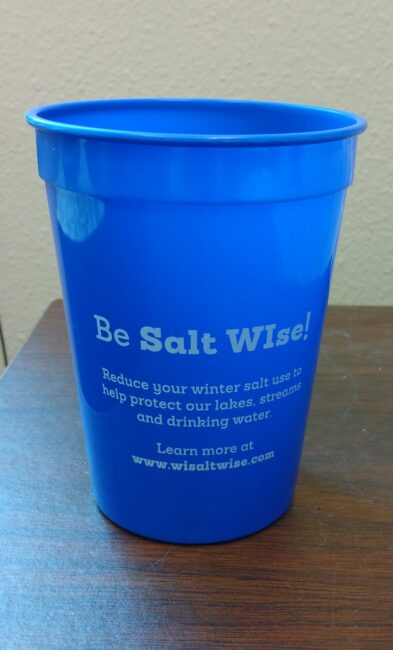January 22, 2024 This past week was Winter Salt Awareness week. Allison Madison, Program Manager for Wisconsin SaltWIse hosted an excellent series of YouTube livestreamed mini-lectures on various topics around winter de-icing salt use. To view the series, visit SaltWISe Winter Salt Awareness week.
With the recent snowfall, you may have used de-icing salt products to keep driveways and sidewalks clear. Excess de-icing salts can damage soils, lakes and streams. It also is hard on the paws of our furry friends out on their daily walks. The City of Madison also passed a new ordinance regarding salt use in December 2022. Under new rules, property owners must limit salt use to only what is needed and have to remove any excess salt left behind on the sidewalk once the snow and ice are gone. Remember that salt is not effective in temperatures below 15°F, so don’t apply unless temperatures are above that level. Chloride is a permanent pollutant and sodium can affect the soil and plant material. It just takes one teaspoon of salt to pollute a five-gallon bucket of water.. It also is hard on the paws of our furry friends out on their daily walks. Excess sodium in soil leads to reduced water infiltration and soil compaction, among other things. It also gets into our drinking water wells.

The U.S. uses 20 million tons of salt each year. About 40 percent of that is road salt. And up to 40% of the applied salt granules can bounce off target when applied (they don’t stay on the road). The City of Madison Public Works Department uses various techniques, such as spraying liquid brine instead of salt pellets to reduce salt use. Liquid brine is about 30% salt, and 70% water which reduces salt use dramatically and does not spread into storm drains by bouncing off the roads as it is applied.
Salt build-up in the soil can eventually stunt or kill plants. Evergreens in particular can be damaged or killed by salt pellets or spray tossed up by snow blowers or shovels. Plants constantly receiving salt spray from passing vehicles are especially prone to damage. Some symptoms include dead twigs (or dead needles on evergreens), leaves with brown margins (usually seen early in spring), dead buds and formation of ‘brooms’ (tight clusters of short twigs) on branch ends. Brooming is especially obvious on trees next to highways. If salting is necessary near plants, mix de-icing salt with sand or use an alternative product such as calcium chloride. Dr. Laura Jull of the UW-Madison Horticulture Department wrote a publication titled ‘Winter Salt Injury and Salt-Tolerant Landscape Plants’ on the effects of salt on woody plants and salt tolerant plants that is available online at Wisconsin Horticulture . Type ‘salt’ into the search box to access it.
If you hire a private company to help with winter maintenance, encourage them to get certified though Madison’s Winter Salt Certification Program.
For more information on de-icing salt visit https://www.wisaltwise.com/ .




